oil YAMAHA XMAX 400 2014 User Guide
[x] Cancel search | Manufacturer: YAMAHA, Model Year: 2014, Model line: XMAX 400, Model: YAMAHA XMAX 400 2014Pages: 92, PDF Size: 7.3 MB
Page 48 of 92

PERIODIC MAINTENANCE AND ADJUSTMENT
6-5
6
11*Steering bearings• Check bearing play and steering
for roughness.√√√√√
• Lubricate with lithium-soap-
based grease.Every 20000 km (12000 mi)
12*Chassis fasteners• Make sure that all nuts, bolts and
screws are properly tightened.√√√√√
13Front brake lever
pivot shaft• Lubricate with silicone grease.√√√√√
14Rear brake lever
pivot shaft• Lubricate with silicone grease.√√√√√
15Sidestand, center-
stand• Check operation.
• Lubricate with lithium-soap-
based grease.√√√√√
16*Sidestand switch• Check operation.√√√√√√
17*Front fork• Check operation and for oil leak-
age.√√√√
18*Shock absorber as-
semblies• Check operation and shock ab-
sorbers for oil leakage.√√√√
19 Engine oil• Change. (See pages 3-6 and
6-13.)√When the oil change indicator flashes
• Check oil level and vehicle for oil
leakage.Every 5000 km (3000 mi)√
20Engine oil filter ele-
ment• Replace.√√√ NO. ITEM CHECK OR MAINTENANCE JOBODOMETER READING
ANNUAL
CHECK 1000 km
(600 mi)10000 km
(6000 mi)
20000 km
(12000 mi)30000 km
(18000 mi)40000 km
(24000 mi)
U1SDE1E0.book Page 5 Monday, September 23, 2013 3:55 PM
Page 49 of 92
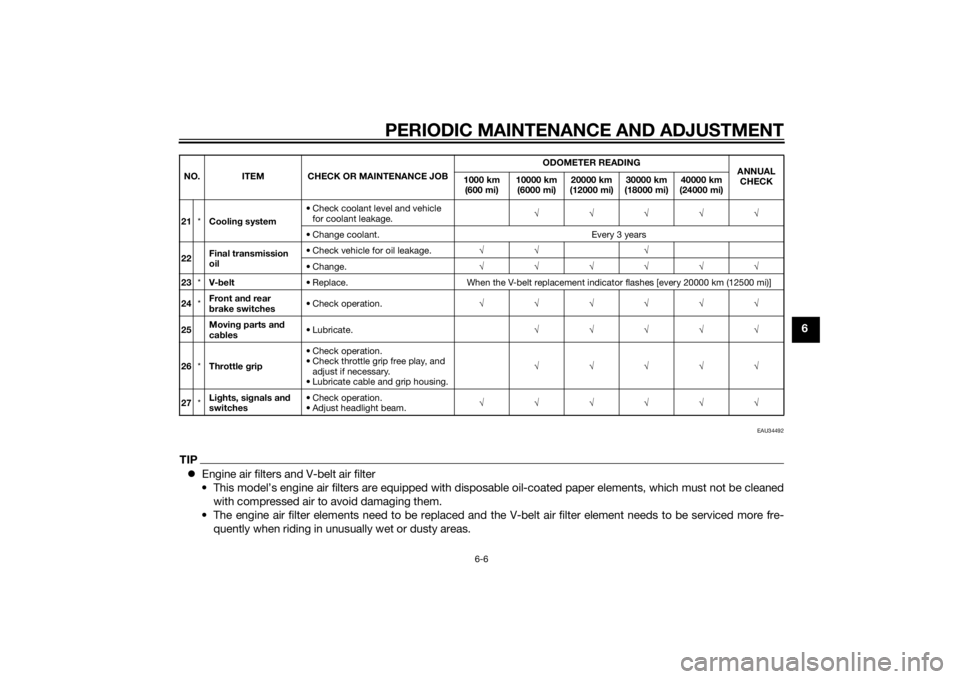
PERIODIC MAINTENANCE AND ADJUSTMENT
6-6
6
EAU34492
TIPEngine air filters and V-belt air filter
• This model’s engine air filters are equipped with disposable oil-coated paper elements, which must not be cleaned
with compressed air to avoid damaging them.
• The engine air filter elements need to be replaced and the V-belt air filter element needs to be serviced more fre-
quently when riding in unusually wet or dusty areas.21*Cooling system• Check coolant level and vehicle
for coolant leakage.√√√√√
• Change coolant. Every 3 years
22Final transmission
oil• Check vehicle for oil leakage.√√ √
• Change.√√√√√√
23*V-belt• Replace. When the V-belt replacement indicator flashes [every 20000 km (12500 mi)]
24*Front and rear
brake switches• Check operation.√√√√√√
25Moving parts and
cables• Lubricate.√√√√√
26*Throttle grip• Check operation.
• Check throttle grip free play, and
adjust if necessary.
• Lubricate cable and grip housing.√√√√√
27*Lights, signals and
switches• Check operation.
• Adjust headlight beam.√√√√√√ NO. ITEM CHECK OR MAINTENANCE JOBODOMETER READING
ANNUAL
CHECK 1000 km
(600 mi)10000 km
(6000 mi)20000 km
(12000 mi)30000 km
(18000 mi)40000 km
(24000 mi)
U1SDE1E0.book Page 6 Monday, September 23, 2013 3:55 PM
Page 56 of 92
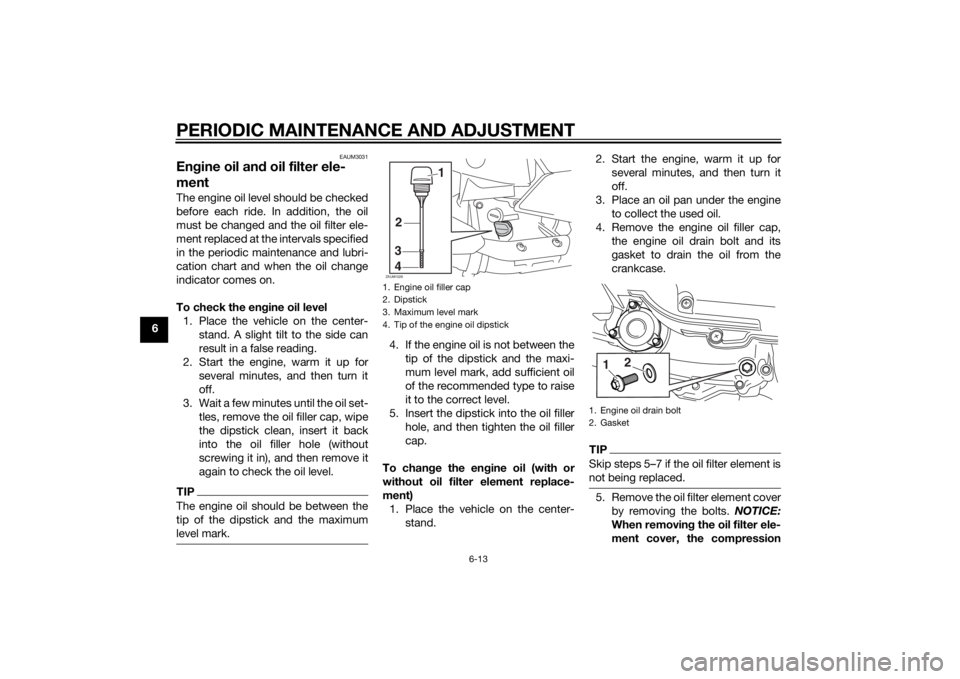
PERIODIC MAINTENANCE AND ADJUSTMENT
6-13
6
EAUM3031
Engine oil and oil filter ele-
mentThe engine oil level should be checked
before each ride. In addition, the oil
must be changed and the oil filter ele-
ment replaced at the intervals specified
in the periodic maintenance and lubri-
cation chart and when the oil change
indicator comes on.
To check the engine oil level
1. Place the vehicle on the center-
stand. A slight tilt to the side can
result in a false reading.
2. Start the engine, warm it up for
several minutes, and then turn it
off.
3. Wait a few minutes until the oil set-
tles, remove the oil filler cap, wipe
the dipstick clean, insert it back
into the oil filler hole (without
screwing it in), and then remove it
again to check the oil level.TIPThe engine oil should be between the
tip of the dipstick and the maximum
level mark.
4. If the engine oil is not between the
tip of the dipstick and the maxi-
mum level mark, add sufficient oil
of the recommended type to raise
it to the correct level.
5. Insert the dipstick into the oil filler
hole, and then tighten the oil filler
cap.
To change the engine oil (with or
without oil filter element replace-
ment)
1. Place the vehicle on the center-
stand.2. Start the engine, warm it up for
several minutes, and then turn it
off.
3. Place an oil pan under the engine
to collect the used oil.
4. Remove the engine oil filler cap,
the engine oil drain bolt and its
gasket to drain the oil from the
crankcase.
TIPSkip steps 5…7 if the oil filter element is
not being replaced.5. Remove the oil filter element cover
by removing the bolts. NOTICE:
When removing the oil filter ele-
ment cover, the compression
1. Engine oil filler cap
2. Dipstick
3. Maximum level mark
4. Tip of the engine oil dipstickZAUM102834
1
2
1. Engine oil drain bolt
2. Gasket
12
U1SDE1E0.book Page 13 Monday, September 23, 2013 3:55 PM
Page 57 of 92
![YAMAHA XMAX 400 2014 User Guide PERIODIC MAINTENANCE AND ADJUSTMENT
6-14
6 spring will fall out. Take care not
to lose the compression spring.
[ECA12912]
6. Remove and replace the oil filter
element and O-rings.7. Install the compre YAMAHA XMAX 400 2014 User Guide PERIODIC MAINTENANCE AND ADJUSTMENT
6-14
6 spring will fall out. Take care not
to lose the compression spring.
[ECA12912]
6. Remove and replace the oil filter
element and O-rings.7. Install the compre](/img/51/53001/w960_53001-56.png)
PERIODIC MAINTENANCE AND ADJUSTMENT
6-14
6 spring will fall out. Take care not
to lose the compression spring.
[ECA12912]
6. Remove and replace the oil filter
element and O-rings.7. Install the compression spring and
oil filter element cover by installing
the bolts, then tightening them to
the specified torque.
TIPMake sure that the O-rings are properly
seated.8. Install the engine oil drain bolt and
its new gasket, and then tighten
the bolt to the specified torque.9. Refill with the specified amount of
the recommended engine oil, and
then install and tighten the oil filler
cap.
TIPBe sure to wipe off spilled oil on any
parts after the engine and exhaust sys-
tem have cooled down.NOTICE
ECA11671
Do not use oils with a diesel
specification of “CD” or oils of a
higher quality than specified. In
1. Bolt
2. Oil filter element cover
21
1. Oil filter element cover
2. O-ring
3. Compression spring
4. Oil filter element
Tightening torque:
Oil filter element cover bolt:
10 Nm (1.0 m·kgf, 7.2 ft·lbf)
1
24
3
Tightening torque:
Engine oil drain bolt:
20 Nm (2.0 m·kgf, 14 ft·lbf)
Recommended engine oil:
See page 8-1.
Oil quantity:
Without oil filter element replace-
ment:
1.50 L (1.59 US qt, 1.32 Imp.qt)
With oil filter element replacement:
1.70 L (1.80 US qt, 1.50 Imp.qt)
U1SDE1E0.book Page 14 Monday, September 23, 2013 3:55 PM
Page 58 of 92
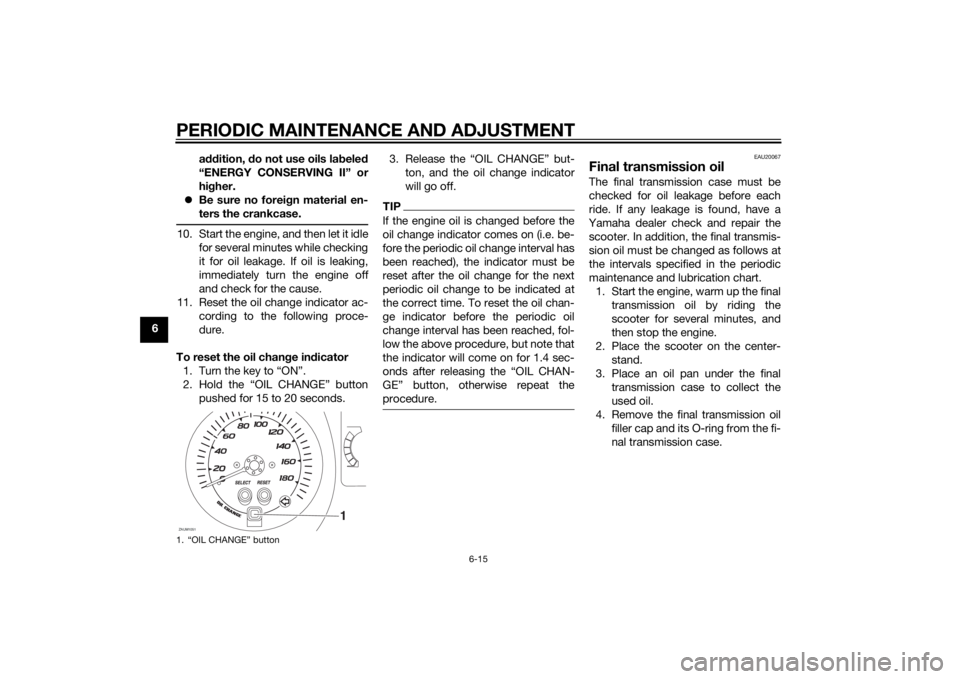
PERIODIC MAINTENANCE AND ADJUSTMENT
6-15
6addition, do not use oils labeled
“ENERGY CONSERVING II” or
higher.
Be sure no foreign material en-
ters the crankcase.
10. Start the engine, and then let it idle
for several minutes while checking
it for oil leakage. If oil is leaking,
immediately turn the engine off
and check for the cause.
11. Reset the oil change indicator ac-
cording to the following proce-
dure.
To reset the oil change indicator
1. Turn the key to “ON”.
2. Hold the “OIL CHANGE” button
pushed for 15 to 20 seconds.3. Release the “OIL CHANGE” but-
ton, and the oil change indicator
will go off.
TIPIf the engine oil is changed before the
oil change indicator comes on (i.e. be-
fore the periodic oil change interval has
been reached), the indicator must be
reset after the oil change for the next
periodic oil change to be indicated at
the correct time. To reset the oil chan-
ge indicator before the periodic oil
change interval has been reached, fol-
low the above procedure, but note that
the indicator will come on for 1.4 sec-
GEŽ button, otherwise repeat the
procedure.
EAU20067
Final transmission oilThe final transmission case must be
checked for oil leakage before each
ride. If any leakage is found, have a
Yamaha dealer check and repair the
scooter. In addition, the final transmis-
sion oil must be changed as follows at
the intervals specified in the periodic
maintenance and lubrication chart.
1. Start the engine, warm up the final
transmission oil by riding the
scooter for several minutes, and
then stop the engine.
2. Place the scooter on the center-
stand.
3. Place an oil pan under the final
transmission case to collect the
used oil.
4. Remove the final transmission oil
filler cap and its O-ring from the fi-
nal transmission case.
1. “OIL CHANGE” buttonZAUM1051
OIL CHANGE
1
U1SDE1E0.book Page 15 Monday, September 23, 2013 3:55 PM
Page 59 of 92
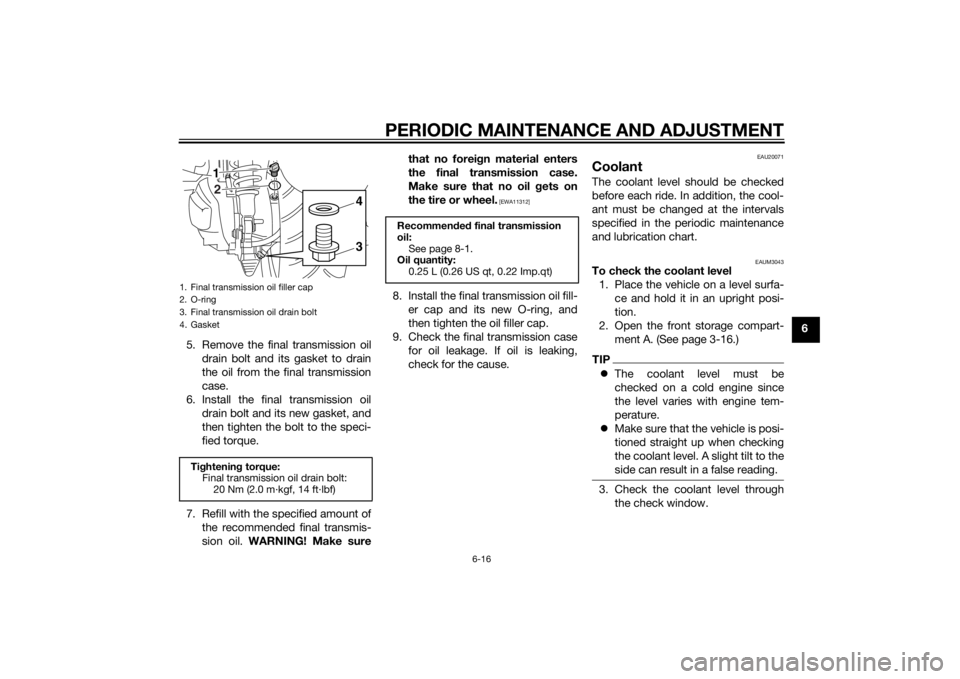
PERIODIC MAINTENANCE AND ADJUSTMENT
6-16
6
5. Remove the final transmission oil
drain bolt and its gasket to drain
the oil from the final transmission
case.
6. Install the final transmission oil
drain bolt and its new gasket, and
then tighten the bolt to the speci-
fied torque.
7. Refill with the specified amount of
the recommended final transmis-
sion oil. WARNING! Make surethat no foreign material enters
the final transmission case.
Make sure that no oil gets on
the tire or wheel.
[EWA11312]
8. Install the final transmission oil fill-
er cap and its new O-ring, and
then tighten the oil filler cap.
9. Check the final transmission case
for oil leakage. If oil is leaking,
check for the cause.
EAU20071
CoolantThe coolant level should be checked
before each ride. In addition, the cool-
ant must be changed at the intervals
specified in the periodic maintenance
and lubrication chart.
EAUM3043
To check the coolant level
1. Place the vehicle on a level surfa-
ce and hold it in an upright posi-
tion.
2. Open the front storage compart-
ment A. (See page 3-16.)TIPThe coolant level must be
checked on a cold engine since
the level varies with engine tem-
perature.
Make sure that the vehicle is posi-
tioned straight up when checking
the coolant level. A slight tilt to the
side can result in a false reading.3. Check the coolant level through
the check window.
1. Final transmission oil filler cap
2. O-ring
3. Final transmission oil drain bolt
4. GasketTightening torque:
Final transmission oil drain bolt:
20 Nm (2.0 m·kgf, 14 ft·lbf)
21
34
Recommended final transmission
oil:
See page 8-1.
Oil quantity:
0.25 L (0.26 US qt, 0.22 Imp.qt)
U1SDE1E0.book Page 16 Monday, September 23, 2013 3:55 PM
Page 68 of 92
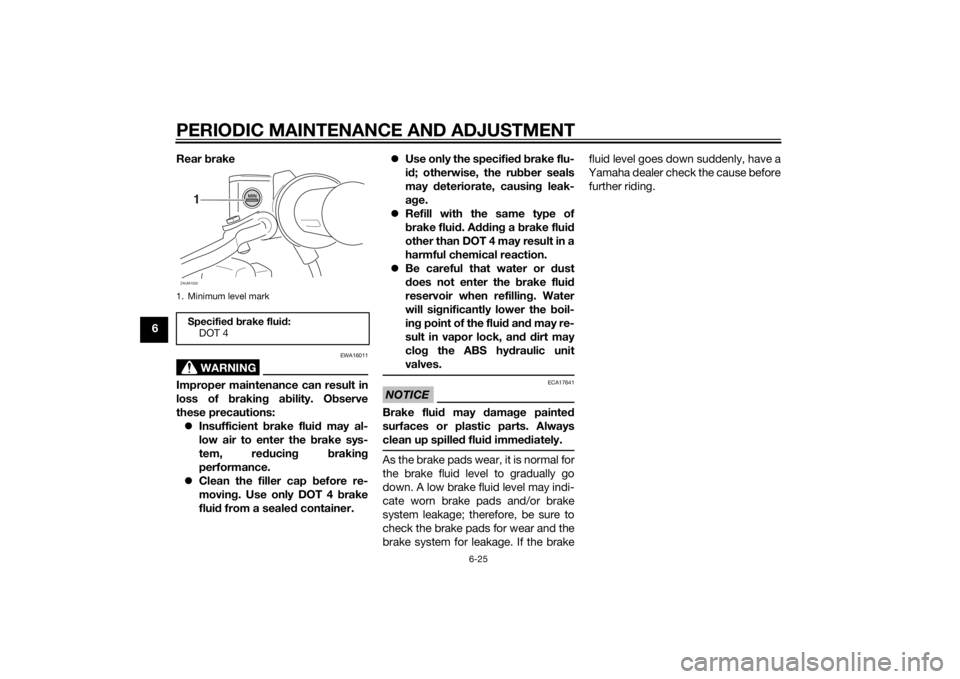
PERIODIC MAINTENANCE AND ADJUSTMENT
6-25
6Rear brake
WARNING
EWA16011
Improper maintenance can result in
loss of braking ability. Observe
these precautions:
Insufficient brake fluid may al-
low air to enter the brake sys-
tem, reducing braking
performance.
Clean the filler cap before re-
moving. Use only DOT 4 brake
fluid from a sealed container.Use only the specified brake flu-
id; otherwise, the rubber seals
may deteriorate, causing leak-
age.
Refill with the same type of
brake fluid. Adding a brake fluid
other than DOT 4 may result in a
harmful chemical reaction.
Be careful that water or dust
does not enter the brake fluid
reservoir when refilling. Water
will significantly lower the boil-
ing point of the fluid and may re-
sult in vapor lock, an
d dirt may
clog the ABS hydraulic unit
valves.
NOTICE
ECA17641
Brake fluid may damage painted
surfaces or plastic parts. Always
clean up spilled fluid immediately.As the brake pads wear, it is normal for
the brake fluid level to gradually go
down. A low brake fluid level may indi-
cate worn brake pads and/or brake
system leakage; therefore, be sure to
check the brake pads for wear and the
brake system for leakage. If the brakefluid level goes down suddenly, have a
Yamaha dealer check the cause before
further riding.
1. Minimum level markSpecified brake fluid:
DOT 4ZAUM1032
1
U1SDE1E0.book Page 25 Monday, September 23, 2013 3:55 PM
Page 69 of 92

PERIODIC MAINTENANCE AND ADJUSTMENT
6-26
6
EAU22733
Changing the brake fluidHave a Yamaha dealer change the
brake fluid at the intervals specified in
the periodic maintenance and lubrica-
tion chart. In addition, have the oil seals
of the master cylinders and calipers as
well as the brake hoses replaced at the
intervals listed below or whenever they
are damaged or leaking.
Oil seals: Replace every two
years.
Brake hoses: Replace every four
years.
EAU23098
Checking and lubricating the
cablesThe operation of all control cables and
the condition of the cables should be
checked before each ride, and the ca-
bles and cable ends should be lubri-
cated if necessary. If a cable is
damaged or does not move smoothly,
have a Yamaha dealer check or re-
place it. WARNING! Damage to the
outer housing of cables may result
in internal rusting and cause inter-
ference with cable movement. Re-
place damaged cables as soon as
possible to prevent unsafe condi-
tions.
[EWA10712]EAU23115
Checking and lubricating the
throttle grip and cableThe operation of the throttle grip
should be checked before each ride. In
addition, the cable should be lubricat-
ed by a Yamaha dealer at the intervals
specified in the periodic maintenance
chart.
The throttle cable is equipped with a
rubber cover. Make sure that the cover
is securely installed. Even though the
cover is installed correctly, it does not
completely protect the cable from wa-
ter entry. Therefore, use care not to
pour water directly onto the cover or
cable when washing the vehicle. If the
cable or cover becomes dirty, wipe
clean with a moist cloth.
Recommended lubricant:
Yamaha cable lubricant or other
suitable cable lubricant
U1SDE1E0.book Page 26 Monday, September 23, 2013 3:55 PM
Page 71 of 92
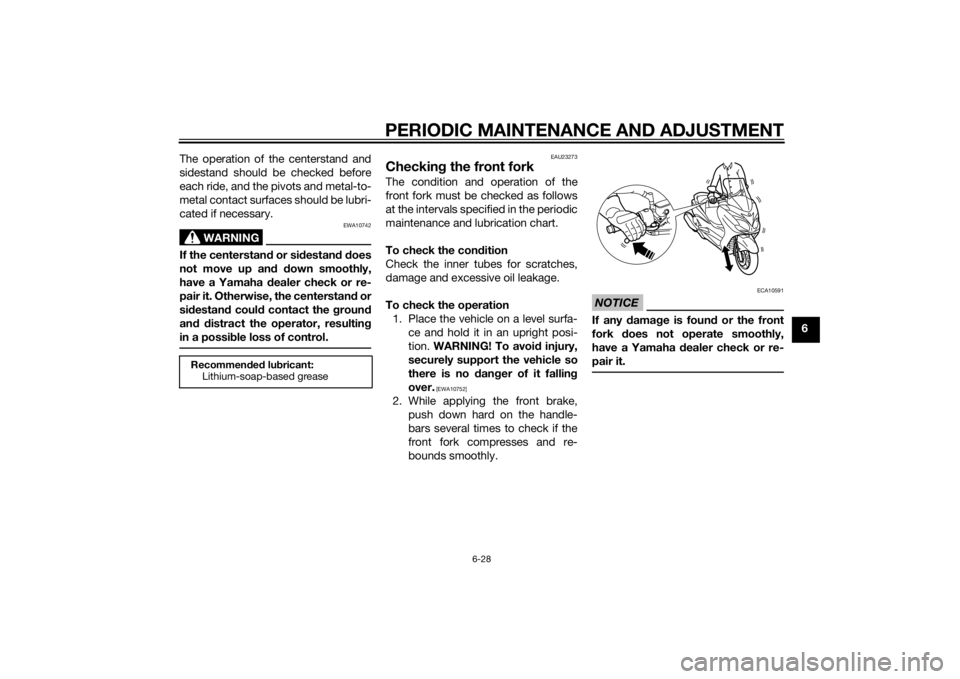
PERIODIC MAINTENANCE AND ADJUSTMENT
6-28
6 The operation of the centerstand and
sidestand should be checked before
each ride, and the pivots and metal-to-
metal contact surfaces should be lubri-
cated if necessary.
WARNING
EWA10742
If the centerstand or sidestand does
not move up and down smoothly,
have a Yamaha dealer check or re-
pair it. Otherwise, the centerstand or
sidestand could contact the ground
and distract the operator, resulting
in a possible loss of control.
EAU23273
Checking the front forkThe condition and operation of the
front fork must be checked as follows
at the intervals specified in the periodic
maintenance and lubrication chart.
To check the condition
Check the inner tubes for scratches,
damage and excessive oil leakage.
To check the operation
1. Place the vehicle on a level surfa-
ce and hold it in an upright posi-
tion. WARNING! To avoid injury,
securely support the vehicle so
there is no danger of it falling
over.
[EWA10752]
2. While applying the front brake,
push down hard on the handle-
bars several times to check if the
front fork compresses and re-
bounds smoothly.
NOTICE
ECA10591
If any damage is found or the front
fork does not operate smoothly,
have a Yamaha dealer check or re-
pair it.
Recommended lubricant:
Lithium-soap-based grease
U1SDE1E0.book Page 28 Monday, September 23, 2013 3:55 PM
Page 81 of 92
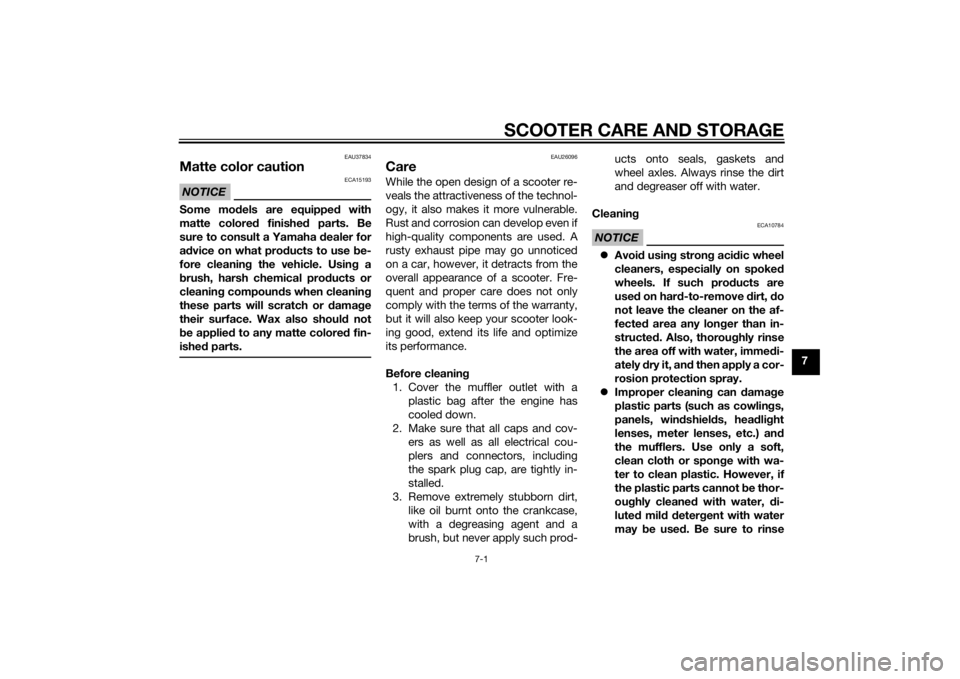
SCOOTER CARE AND STORAGE
7-1
7
EAU37834
Matte color cautionNOTICE
ECA15193
Some models are equipped with
matte colored finished parts. Be
sure to consult a Yamaha dealer for
advice on what products to use be-
fore cleaning the vehicle. Using a
brush, harsh chemical products or
cleaning compounds when cleaning
these parts will scratch or damage
their surface. Wax also should not
be applied to any matte colored fin-
ished parts.
EAU26096
CareWhile the open design of a scooter re-
veals the attractiveness of the technol-
ogy, it also makes it more vulnerable.
Rust and corrosion can develop even if
high-quality components are used. A
rusty exhaust pipe may go unnoticed
on a car, however, it detracts from the
overall appearance of a scooter. Fre-
quent and proper care does not only
comply with the terms of the warranty,
but it will also keep your scooter look-
ing good, extend its life and optimize
its performance.
Before cleaning
1. Cover the muffler outlet with a
plastic bag after the engine has
cooled down.
2. Make sure that all caps and cov-
ers as well as all electrical cou-
plers and connectors, including
the spark plug cap, are tightly in-
stalled.
3. Remove extremely stubborn dirt,
like oil burnt onto the crankcase,
with a degreasing agent and a
brush, but never apply such prod-ucts onto seals, gaskets and
wheel axles. Always rinse the dirt
and degreaser off with water.
Cleaning
NOTICE
ECA10784
Avoid using strong acidic wheel
cleaners, especially on spoked
wheels. If such products are
used on hard-to-remove dirt, do
not leave the cleaner on the af-
fected area any longer than in-
structed. Also, thoroughly rinse
the area off with water, immedi-
ately dry it, and then apply a cor-
rosion protection spray.
Improper cleaning can damage
plastic parts (such as cowlings,
panels, windshields, headlight
lenses, meter lenses, etc.) and
the mufflers. Use only a soft,
clean cloth or sponge with wa-
ter to clean plastic. However, if
the plastic parts cannot be thor-
oughly cleaned with water, di-
luted mild detergent with water
may be used. Be sure to rinse
U1SDE1E0.book Page 1 Monday, September 23, 2013 3:55 PM